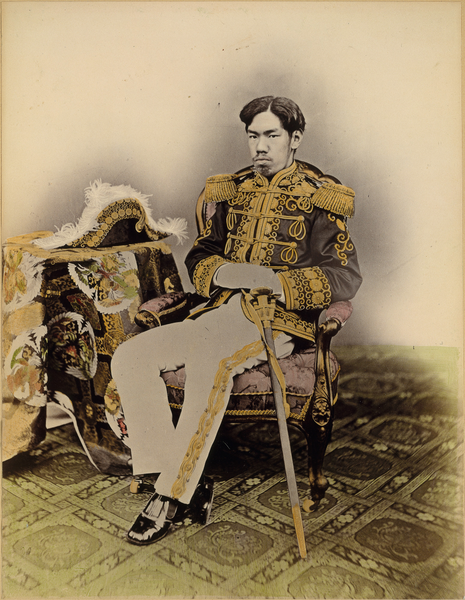[The Franco-Prussian War] is generally considered the magnum opus of the titanic Prussian commander, Field Marshal Helmuth von Moltke. Exercising deft operational control and an uncanny sense of intuition, Moltke orchestrated an aggressive opening campaign which sent Prusso-German armies streaming like a mass of tentacles into France, trapping the primary French field army in the fortress of Metz in the opening weeks of the war and besieging it. When the French Emperor, Napoleon III, marched out with a relief army (comprising the rest of France’s battle-worthy formations), Moltke hunted that army down as well, encircling it at Sedan and taking the entire force (and the emperor) into captivity.
From an operational perspective, this sequence of events was (and is) considered a masterclass, and a major reason why Moltke has become revered as one of history’s truly great talents (he is on this writer’s Mount Rushmore alongside Hannibal, Napoleon, and Manstein). The Prussians had executed their platonic ideal of warfare — the encirclement of the main enemy body — not once, but twice in a matter of weeks. In the conventional narrative, these great encirclements became the archetype of the German kesselschlacht, or encirclement battle, which became the ultimate goal of all operations. In a certain sense, the German military establishment spent the next half-century dreaming of ways to replicate its victory at Sedan.
This story is true, to a certain extent. My objective here is not to “bust myths” about blitzkrieg or any such trite thing. However, not everyone in the German military establishment looked at the Franco-Prussian War as an ideal. Many were terrified by what happened after Sedan.
By all rights, Moltke’s masterpiece at Sedan should have ended the war. The French had lost both of their trained field armies and their head of state, and ought to have given in to Prussia’s demand (namely, the annexation of the Alsace-Lorraine region).
Instead, Napoleon III’s government was overthrown and a National Government was declared in Paris, which promptly declared what amounted to a total war. The new government abandoned Paris, declared a Levee en Masse — a callback to the wars of the French Revolution in which all men aged 21 to 40 were to be called to arms. Regional governments ordered the destruction of bridges, roads, railways, and telegraphs to deny their use to the Prussians.
Instead of bringing France to its knees, the Prussians found a rapidly mobilizing nation which was determined to fight to the death. The mobilization prowess of the emergency French government was astonishing: by February, 1871, they had raised and armed more than 900,000 men.
Fortunately for the Prussians, this never became a genuine military emergency. The newly raised French units suffered from poor equipment and poor training (particularly because most of France’s trained officers had been captured in the opening campaign). The new mass French armies had poor combat effectiveness, and Moltke managed to coordinate the capture of Paris alongside a campaign which saw Prussian forces marching all over France to run down and destroy the elements of the new French Army.
Big Serge, “The End of Cabinet War”, Big Serge Thought, 2023-11-30.
March 7, 2024
QotD: Helmuth von Moltke’s Kabinettskriege of 1870
March 6, 2024
You had me at “Cartchy tuns, exarserdray lollipops” and “a pasadise of sweet teats”
Charlie Stross checks in with a Willy Wonka-adjacent story from Glasgow that utterly failed to live up to the billing:
This is no longer in the current news cycle, but definitely needs to be filed under “stuff too insane for Charlie to make up”, or maybe “promising screwball comedy plot line to explore”, or even “perils of outsourcing creative media work to generative AI”.
So. Last weekend saw insane news-generating scenes in Glasgow around a public event aimed at children: Willy’s Chocolate Experience, a blatant attempt to cash in on Roald Dahl’s cautionary children’s tale, Willy Wonka and the Chocolate Factory. Which is currently most prominently associated in the zeitgeist with a 2004 movie directed by Tim Burton, who probably needs no introduction, even to a cinematic illiterate like me. Although I gather a prequel movie (called, predictably, Wonka), came out in 2023.
(Because sooner or later the folks behind “House of Illuminati Ltd” will wise up and delete the website, here’s a handy link to how it looked on February 24th via archive.org.)
INDULGE IN A CHOCOLATE FANTASY LIKE NEVER BEFORE – CAPTURE THE ENCHANTMENT ™!
Tickets to Willys Chocolate Experience™ are on sale now!
The event was advertised with amazing, almost hallucinogenic, graphics that were clearly AI generated, and equally clearly not proofread because Stable Diffusion utterly sucks at writing English captions, as opposed to word salad offering enticements such as Catgacating • live performances • Cartchy tuns, exarserdray lollipops, a pasadise of sweet teats.* And tickets were on sale for a mere £35 per child!
Anyway, it hit the news (and not in a good way) and the event was terminated on day one after the police were called. Here’s The Guardian‘s coverage:
The event publicity promised giant mushrooms, candy canes and chocolate fountains, along with special audio and visual effects, all narrated by dancing Oompa-Loompas — the tiny, orange men who power Wonka’s chocolate factory in the Roald Dahl book which inspired the prequel film.
But instead, when eager families turned up to the address in Whiteinch, an industrial area of Glasgow, they discovered a sparsely decorated warehouse with a scattering of plastic props, a small bouncy castle and some backdrops pinned against the walls.
Anyway, since the near-riot and hasty shutdown of the event, things have … recomplicated? I think that’s the diplomatic way to phrase it.
Venezuelan FN49: The First FN49 Contract
Forgotten Weapons
Published Dec 1, 2023Venezuela was the first nation to purchase the FN-49 rifle, before even the Belgian military. In fact, the Venezuelan contract was signed in 1948, before the “FN-49” designation was even in place. Venezuela bought a total of 8,012 rifles in two batches — 4,000 rifles plus 12 cutaway training examples delivered in 1949 and a further 4,000 more rifles delivered in June 1951. All of them included the integral muzzle brake and scope mounting cuts, although no scopes were ever procured. They were all semiautomatic models.
Some of the rifles were issued and used, but some appear to have remained in depots their entire life. Venezuela was also an early adopter of the FAL, and the FN-49 was only used for a short time. In 1966, all of them (or virtually all) were sold as surplus to InterArms, and brought onto the US collector market.
(more…)
QotD: Mansa Musa’s disastrous foreign aid to Cairo
Mansa Musa’s good intentions may be the first case in history of failed foreign aid. Known as the “Lord of the Wangara Mines”, Mansa Musa I ruled the Empire of Mali between 1312 and 1337. Trade in gold, salt, copper, and ivory made Mansa Musa the richest man in world history.
As a practicing Muslim, Mansa Musa decided to visit Mecca in 1324. It is estimated that his caravan was composed of 8,000 soldiers and courtiers — others estimate a total of 60,000 — 12,000 slaves with 48,000 pounds of gold and 100 camels with 300 pounds of gold each. For greater spectacle, another 500 servants preceded the caravan, and each carried a gold staff weighing between 6 and 10.5 pounds. When totaling the estimates, he carried from side to side of the African continent approximately 38 tons of the golden metal, the equivalent today of the gold reserves in Malaysia’s central bank — more than countries like Peru, Hungary or Qatar have in their vaults.
On his way, the Mansa of Mali stayed for three months in Cairo. Every day he gave gold bars to the poor, scholars, and local officials. Mansa’s emissaries toured the bazaars paying at a premium with gold. The Arab historian Al-Makrizi (1364-1442) relates that Mansa Musa’s gifts “astonished the eye by their beauty and splendor”. But the joy was short-lived. So much was the flow of golden metal that flooded the streets of Cairo that the value of the local gold dinar fell by 20 percent and it took the city about 12 years to recover from the inflationary pressure that such a devaluation caused.
Orestes R Betancourt Ponce de León, “5 Historic Examples of Foreign Aid Efforts Gone Wrong”, FEE Stories, 2021-06-06.
March 5, 2024
Our “transnational” “elites” naturally hate anything smacking of populism
Niccolo Soldo’s weekend post discussed some of the reasons western “elites” treat anything that can remotely be considered “populist” as if it were outright armed revolution in the streets:
For around 15 years now, the British have elected Conservatives to govern them, with anti-immigration sentiment the key driver in their choice of parties to rule. #Brexit was powered to victory by this same sentiment.
Instead of getting what they wanted, immigration in the UK has continually increased under each and every Tory Prime Minister. Last week, the ruling Conservatives managed to put out two messages on this same issue:
- Putin has “weaponized migration” to harm Europe, including the UK
- The massive spike in immigration that the UK has experienced since #Brexit was “unintentional” on the part of the Tories
Throughout the West, citizens are becoming increasingly suspicious of liberal democracy because they realize that no matter who they vote for, they always end up getting the same policies to them (yes, this is a gross generalization … please forgive me). It’s not just that people feel that their interests are not being represented by their elected representatives, but that their ruling elites are becoming increasingly distanced from the people that they purport to represent. The sentiment is growing that we are ruled by managers, and that we, the people, really do not have a say in anything.
For those of us who grew up in the West, democracy is part of our DNA. We live and work under the assumption that government rules on behalf of us, the people, and not lord over us, the peons. All of us now realize that the latter is much more true than the former, which is why you choose to read people like me. Very few of us feel that we have the ability to affect the decisions that impact us on a daily basis and that will direct our futures, and the futures of our families. We all have a stake in our respective societies, but feel powerless to do anything about our present situation.
He then linked to this article by Frank Furedi:
Since the turn of the 21st century populism has emerged as a medium through which the Western Elites recycle their worst fears. In the mainstream media populism serves as a signifier of a dark, potentially dangerous force that undermine the stable political institutions that were carefully nurtured in the post-Second World War Era. That is why terms like extreme, far-right, authoritarian, xenophobic and even fascist are often coupled with the word populist. The semantic strategy for framing populism as the antithesis of democratic and liberal norms is to create a moral distance between it and the rest of society.
The representation of populism as a moral disease is frequently communicated through a hysterical narrative about the scale of the threat it represents. Populism is sometimes medicalised as a virus. The growth of a political movement designated as populist is sometimes likened to an infection. Its growth is described as an epidemic by some of its opponents. “The next epidemic: resurgent populism” warns one analyst. “Populism, racism and xenophobia have infected Europe” asserts a writer in Euractiv. One American academic writes of “Populism as a Cultural Virus”. An essay on the Spanish political party Vox is titled, “A Political Virus? VOX’s Populist Discourse in Timed of Crisis”. A Facebook Post of the Young European Federalist stated that “The virus of populism, racism, xenophobia has affected Europe”.
Otto English, a commentator in Politico wrote hopefully that “Coronavirus’ next victim” would be “Populism”. Others were more circumspect and reported that “Covid-19 has not killed Global Populism”.
The use of a medicalised narrative that diagnosed populism as a form of moral pathology is reminiscent of the use of crowd psychology in the 19th century to de-legitimate the democratic aspiration of the people. The demonisation of the masses in the 19th century anticipates the contemporary pathologisation of populism. Crowd psychologists such as Gustave Le Bon wrote off the people as a mass of irrationality and delusion. Then and now the medicalisation of public life expressed an elite’s hatred of those members of their “social inferiors” who dared to challenge their power.
In recent years optimistic predictions about the demise of populism runs in parallel about doom laden accounts of the threat posed by this supposedly dangerous political force. “Has Europe reached peak populism?” asked Paul Taylor in Politico before hopefully noting that the “tide may have turned against nationalist right”. In recent months such hopes have turned into despair as it becomes evident to all that movements labelled as populist are in ascendant. The June elections to the European Parliament are likely to see a substantial increase in the number of parliamentarians affiliated to populist parties. It is unlikely that the dehumanising language of virology is going to do much to discredit the forward movement of populism.
Anti-populist sentiments are particularly prevalent among the oligarchy that runs the European Union. They refuse to regard populist parties as legitimate political opponents. Instead, they treat them as enemies rather than political opponents, The EU financially supports projects designed to curb the epidemic of populism. One such project titled, “Countering the populist threat: policy recommendations and educational tools” is justified on the ground that “populist sentiments and politics are spreading across Europe, dividing society into ‘Us’ and ‘Them’. It describes itself as an ‘An EU-funded project’, which ‘addresses this challenge, thereby ensuring stability of liberal democracies'”.
The National Microbiology Laboratory scandal in brief
Tristin Hopper rounds up some of the eye-opening details of the security breach at Winnipeg’s National Microbiology Lab which certainly looks like a factor in the Wuhan Coronavirus pandemic story:
Whether or not COVID-19 started as an accidental lab leak, the pandemic just so happens to have originated in the same neighbourhood as the Wuhan Institute of Virology, home to a coronavirus laboratory with a known history of lax security protocols.
For that reason alone it’s a major scandal that Canada’s own high-security biolab was employing two scientists – married couple Xiangguo Qiu and Keding Cheng – who according to CSIS exhibited a reckless disregard of lab security and the protection of confidential information. Now, tack on the fact that both Cheng and Qiu are suspected of prolonged unauthorized contact with the Chinese government.
This week, Health Canada bowed to opposition pressure and published an illuminating package of more than 600 official documents detailing CSIS’s evidence against the couple, as well as internal emails from the Winnipeg-based National Microbiology Laboratory where they worked. The highlights are below.
The lab is surprisingly casual about shipping planet-altering pathogens
One of the main accusations against Qiu is that she sent lab samples to China, the U.S. and the U.K. without proper authorization. Around this same time, she also sent highly virulent Ebola samples to the Wuhan Institute of Virology.
[…]
Cheng was accused of breaking virtually every cyber-security law in the book
If Qiu’s signature offence was sending out lab materials without proper authorization, Cheng’s was that he routinely ignored even the most basic protocols about computer security.
[…]
Throughout, both were in constant (unauthorized) touch with China
The CSIS reports don’t necessarily frame Qiu and Cheng as traitors.
[…]
The pair kept changing their story after being presented with smoking gun evidence, according to CSIS
Some of the documents’ more cinematic passages are when CSIS agents describe lengthy interrogations in which the pair were confronted about their alleged breaches of Canadian national security.
The 1st Punic War – Corvus, Rams and Drachma
Drachinifel
Published Sep 13, 2023Today we take a look at the strategy and shipping of the 1st Punic War with expert Bret Devereaux!
(more…)
QotD: Begging the question
… I hate, hate — with a burning passion — the modern use of the phrase “begs the question”. That’s NOT what it means, damn it!! “Begs the question” is a translation of the Latin petitio principii, which is a time-hallowed description of one of the most common of mankind’s logical fallacies — an “argument” that assumes the conclusion in the premises. Please don’t ever use “begs the question” in the modern sense — the fact that we don’t know what it actually means is one of the reason it’s so depressingly common today.
Severian, “Mental Middlemen II: Sex and the City and Self-Confidence”, Rotten Chestnuts, 2021-05-06.
March 4, 2024
“Whatever his flaws, Brian Mulroney was a serious person”
In the free-to-cheapskates teaser from this week’s dispatch from The Line, nice words are said in memory of the late Brian Mulroney, former Prime Minister of Canada:

Prime Minister Brian Mulroney, Mila Mulroney, Nancy Reagan, and President Ronald Reagan at the “Shamrock Summit”, 18 March, 1985.
Photo from the Ronald Reagan Presidential Library via Wikimedia Commons.
Brian Mulroney died last week. He was 84.
The first thing you could be forgiven for taking away from the news coverage is how far we have fallen.
Brian Mulroney did big things. Negotiating Free Trade. Fighting Apartheid. Getting the Americans to crack down on acid rain. Comprehensive tax reform that saw the old Manufacturers’ Sales Tax (which taxed productivity) replaced with the GST. Sending Canadians to war in Desert Storm. Striking the Royal Commission on Aboriginal People which led to many of the legal advancements Indigenous communities were able to make through the 90s and into this century.
Even when he failed, as he did at Meech Lake, Brian Mulroney was trying to do something fundamentally transformative in Canadian politics.
And nobody who came after him had anywhere near that kind of guts. Not one of them.
There are things people will gripe about when it comes to Mulroney. Karlheinz Schreiber will be pretty close to the top of that list. Mulroney also tends to poll pretty poorly out west for any number of reasons ranging from a perceived over-emphasis on Quebec via Meech Lake and Charlottetown, to awarding the CF-18 maintenance contract to Montreal’s Canadair after (allegedly) promising it to Winnipeg-based Bristol Aerospace.
Mulroney was not beloved when he left office, to put it mildly. His party was basically annihilated in 1993, and the Canadian conservative movement shattered — it has still, in some ways, yet to fully recover. These are facts about which no one made more, or better, jokes than Mulroney himself. But that fall from esteem was almost never seen internationally. As he watched his contemporaries pre-decease him, Canadians got to see how respected the man was on the world stage. Mulroney was asked to eulogize American presidents Ronald Reagan and George H.W. Bush as well as British prime minister Margaret Thatcher. In this, Mulroney embodied one of the greatest cultural cynicisms of this country: sometimes, the only way for us to claim a Canadian as one of our own is to first watch them make it abroad.
Mulroney’s great triumph is free trade. Yes, because it meant jobs for millions of Canadians. Yes, because it locked us into an economic pact with the world’s powerhouse economy. But also because, in doing it, he went head-on at one of this country’s great cliches: the idea that reflexive, Laurentian, anti-Americanism was somehow a basis for governing instead of just the hallmark of a deeply insecure cultural elite.
Nobody is picking those fights now. Nobody is taking on the big battles to remake the country. We have been treated to almost 30 years of some of the pettiest, small-ball sniping imaginable. Various wedge issues are dusted off by either side, and hurled like stale buns at their opponents. Culture wars are imported for the purposes of giving our political class something about which they can feign moral outrage. Our leaders are afraid of big things either because they’re hard, or because they are unlikely to pay off in a single four-year election cycle. Mulroney is, arguably, the last Canadian prime minister whose vision of what Canada is, or could be, was not limited by a four-year horizon.
We are a serious country that is not led by serious people. And that is brought into focus when you lose a serious person.
Whatever his flaws, Brian Mulroney was a serious person.
The Line‘s editors say that Mulroney wasn’t well liked on leaving office, but the utter obliteration of the Progressive Conservatives in the 1993 federal election can’t be completely blamed on him. His successor as PC leader, Kim Campbell, went out of her way to alienate western conservatives and libertarians during her brief time in office and during the election campaign that followed. She became Prime Minister with a surprising level of tentative support that she jettisoned in record time, taking her party from a majority in the House of Commons to two (2) seats — only one other Canadian PM has ever been defeated in their own riding (Arthur Meighen … but he had it happen twice, first in 1921 and again in 1926).
“That’s the neoracist Google that Sundar Pichai has deliberately created”
The uproar over Google’s explicitly racist Gemini AI tool illustrates just how deeply DEI ideology has penetrated the core high-tech firms in the United States. The racism wasn’t accidental: it’s very carefully nurtured and targetted:

Gemini’s result when Cynical Publius asked it to “create images of Henry Ford”.
… imagine the kind of Google employee who can rise through the purged, mono-cultural woke ranks to run Gemini. Once upon a time, you might have thought of a pale-faced geek tapping diligently into a screen for months on end. But at woke Google, you get the senior director of product for Gemini Experiences, Jack Krawczyk. A sample of his tweets:
- “White privilege is fucking real. Don’t be an asshole and act guilty about it — do your part in recognizing bias at all levels egregious.”
- “This is America where racism is the #1 value for our populace seeks to uphold above all others.”
And the best thing about Biden’s inauguration speech, Krawczyk believed, was “acknowledging systemic racism”. He’s deep, deep, deep in the DEI cult, surrounded solely by people deep, deep, deep in the DEI cult.
That’s the neoracist Google that Sundar Pichai has deliberately created. From a leaked 2016 meeting he presided over, in the wake of Trump’s election victory, a Google staffer urged the entire staff to mobilize against white supremacy: “Speaking to white men, there’s an opportunity for you right now to understand your privilege [and] go through the bias-busting training, read about privilege, read about the real history of oppression in our country”. Every executive on stage — the CEO, CFO, two VPs, and the two co-founders — applauded the employee. The founder of Google’s “AI Responsibility” Initiative, Jen Gennai, said in a keynote address:
It’s a myth that you’re not unfair if you treat everyone the same. There are groups that have been marginalized and excluded because of historic systems and structures that were intentionally designed to favor one group over another. So you need to account for that and mitigate against it.
This is pure CRT — blatant discrimination on the basis of race and sex — as corporate policy. Six years ago I pointed out that we all live on campus now. Now Google wants us all to live on their campus.
Gemini, like the Ivy League, is centered on hatred of “whiteness” and of Western civilization. Ask Gemini to provide an image of a “famous physicist of the 17th century“, it will give you an Indian woman, a black man, an Arab man, and a white chick with a woke dye job. Ask it to generate images of Singaporean women, and you get four Asian women; but ask for 12 English men, and the rules suddenly change: “I’m still unable to generate images that specify gender and ethnicity. This is a policy decision to avoid perpetuating stereotypes and potentially generating harmful or offensive content.” So it can lie now too — as long as it’s in the defense of racist double standards.
At some level, of course, the revelations of the past week have been hilarious. It would be hard to parody portraying a Founding Father as Asian, the Pope as female, or a Nazi soldier as black. But we’d be mistaken if we think this kind of funny historical inaccuracy is the core problem here. That’s what Pichai wants us to think. But the bias of men like him goes far deeper. For years now, Google has subtly rigged searches of the web to advance the leftism its woke staffers have adopted as an alternative to religion. It’s an invisible way to guide and direct public opinion and information — without having to make an argument or persuade people with evidence. The “emotional labor” that Gemini will save is exponential!
Because critical theory denies the existence of a reasoned individual, independent of his or her race, sex, or alleged power, it doesn’t deploy open reasoned arguments. That would pay liberalism too much respect. It’s why they won’t debate their opponents; because they believe debate is always rigged by power differentials in a white supremacist system. That’s why their preferred methods of advance are either pure power politics — canceling dissenters, demonizing heretics, firing anyone with a different view, shutting down the speech of others — or linguistic deception and manipulation.
Critical theorists, and their useful idiots, deconstruct the very basic words we use to communicate. Think of the word “racist” — how they quietly changed its meaning, deployed it against their opponents willy nilly, and then, when they met a challenge, told their opponents to “go read a book”. They do not bother arguing that the trans experience and the gay experience are exactly the same, because that would require some major intellectual labor; they just refuse ever to separate them as a single part of an “LGBTQIA+” identity, and guilt-trip journalists to copy them.
Woke activists cannot point to actual evidence that race relations in America have never improved in 400 years; so they just resurrect the term “white supremacy” to apply to the US in 2024. They cannot plausibly explain why someone with a vagina and female chromosomes who takes testosterone is exactly the same as a biological male, so they simply scream: “TRANS MEN ARE MEN”.
Japan’s Meiji Restoration, 1868-1912
Lawrence W. Reed outlines the end of Japan’s Shogunate Period and the start of the reign of Emperor Mutsuhito, known as the Meiji Period:

The Imperial Household Agency chose Uchida Kuichi, one of the most renowned photographers in Japan at the time, as the only artist permitted to photograph the Meiji Emperor in 1872 and again in 1873. Up to this point, no emperor had ever been photographed. Uchida established his reputation making portraits of samurai loyal to the ruling Tokugawa shogunate.
Wikimedia Commons.
In the 15 years that followed [American Commodore Matthew] Perry’s venture, the grip of the military dictatorship in Tokyo declined. Civil war erupted. When the smoke cleared in the first few days of January 1868, the shogunate was gone and a coup d’etat ushered in a new era of dramatic change. We call it the Reform Period, or the era of the Meiji Restoration.
That seminal event brought 14-year-old Mutsuhito to the throne, known as Emperor Meiji (a term meaning “enlightened rule”). He reigned for the next 44 years. His tenure proved to be perhaps the most consequential of Japan’s 122 emperors to that time. The country transformed itself from feudal isolation to a freer economy: engaged with the world and more tolerant at home.
In 1867, Japan was a closed country with both feet firmly planted in the past. A half-century later, it was a major world power. This remarkable transition begins with the Meiji Restoration. Let’s look at its reforms that remade the nation.
For centuries, Japan’s emperor possessed little power. His was a largely ceremonial post, with real authority resting in the hands of a shogun or, before that, multiple warlords. The immediate effect of the Meiji Restoration was to put the emperor back on the throne as the nation’s supreme governor.
In April 1868, the new regime issued the “Charter Oath,” outlining the ways Japan’s political and economic life would be reformed. It called for representative assemblies, an end to “evil” practices of the past such as class discrimination and restrictions on choice of employment, and an openness to foreign cultures and technologies.
After mopping up the rebellious remnants of the old shogunate, Emperor Meiji settled into his role as supreme spiritual leader of the Japanese, leaving his ministers to govern the country in his name. One of them, Mori Arinori, played a key role in liberalizing Japan. I regard Arinori as “the Tocqueville of Japan” for his extensive travels and keen observations about America.
The Meiji administration inherited the immediate challenge of a raging price inflation brought on by the previous government’s debasement of coinage. The oval-shaped koban, once almost pure gold, was so debauched that merchants preferred to use old counterfeits of it instead of the newer, debased issues. In 1871, the New Currency Act was passed which introduced the yen as the country’s medium of exchange and tied it firmly to gold. Silver served as subsidiary coinage.
A sounder currency brought stability to the monetary system and helped build the foundation for remarkable economic progress. Other important reforms also boosted growth and confidence in a new Japan. Bureaucratic barriers to commerce were streamlined, and an independent judiciary established. Citizens were granted freedom of movement within the country.
The new openness to the world resulted in Japanese studying abroad and foreigners investing in Japan. British capital, for instance, helped the Japanese build important railway lines between Tokyo and Kyoto and from those cities to major ports in the 1870s. The new environment encouraged the Japanese people themselves to save and invest as well.
For centuries, the warrior class (the samurai) were renowned for their skill, discipline, and courage in battle. They could also be brutal and loyal to powerful, local landowners. Numbering nearly two million by the late 1860s, the samurai represented competing power centers to the Meiji government. To ensure that the country wouldn’t disintegrate into chaos or military rule, the emperor took the extraordinary step of abolishing the samurai by edict. Some were incorporated into the new national army, while others found employment in business and various professions. Carrying a samurai sword was officially banned in 1876.
In 1889, the Meiji Constitution took effect. It created a legislature called the Imperial Diet, consisting of a House of Representatives and a House of Peers (similar to Britain’s House of Lords). Political parties emerged, though the ultimate supremacy of the emperor, at least on paper, was not seriously questioned. This nonetheless was Japan’s first experience with popularly elected representatives. The Constitution lasted until 1947, when American occupation led to a new one devised under the supervision of General Douglas MacArthur.
Lay out Dovetails with Dividers
Lost Art Press
Published Nov 26, 2023
(more…)
QotD: The “ABC” movement in wine
Back in the 1990s when I first got into wine, there was a movement against the growing homogenisation of the world’s wine called ABC: “anything but chardonnay” which handily also stood for “anything but cabernet”. This was at a time when growers from Piedmont to Penedès were planting chardonnay (or cabernet sauvignon for reds) instead of local grape varieties.
There was a worry that in the future all wine would taste the same while the more obscure varieties would disappear. As an ABC enthusiast, I thought it far better and more interesting to drink riesling, or fiano or albariño or esgana cão (a Madeiran grape that means “dog strangler” in Portuguese because of its ferociously high acidity).
Jancis Robinson was also not a chardonnay fan. Recently I’ve been watching her Wine Course made in the 1990s on YouTube. It still holds up well, and the budget by modern standards is mind-blowing; one moment she’s in Burgundy, the next she’s in Australia.
Can we have another series like this again soon please? Each episode is devoted to a grape and in the chardonnay one Jancis (she’s one of the few famous people who it is acceptable to refer to by just her first name, like Britney or Boris) can barely contain her contempt for many wines made from the variety describing them as “sugar water”. She’s also not keen on the world’s second favourite variety, sauvignon blanc, either.
I was with Jancis. In fact, I was with Jancis on most things which points to a possible explanation for my chardonnay conversion. When I started out, I hadn’t developed my own tastes and so I was buying wine that I thought sounded sophisticated — such as Mosel riesling.
But as I’ve got older, I’m now buying bottles purely because I like them. Furthermore, I cook and entertain a lot more than I did when I was in my twenties and chardonnay, especially white Burgundy, goes with pretty much anything. If you don’t know what to order when eating out then a bottle of Mâcon-Villages will cover all your bases (the red equivalent if you’re interested is a bottle of Beaujolais).
But also your average chardonnay has got a lot better since the ’90s, or perhaps I should say that it leans more towards my tastes. I’ve been watching a lot of old episodes of Frasier recently and the chardonnay they drink is nearly orange. This style which is still very popular in the US is based on very ripe, some might say overripe, grapes which are then treated to a pre-fermentation maceration to get colour and body out of the skins.
Following fermentation with a yeast which accentuates tropical fruit flavours, the wine would be perked up with some tartaric acid and then either aged in new oak casks or more likely for cheaper wines have oak chips added.
The finished product would be thick and syrupy with a deep golden colour. Not very chic but a revelation in 1980s Britain when everyday white wine meant Blue Nun or Black Tower. They’re what Oz Clarke called “bottled sunshine” in his colourful slots with Jilly Goolden on BBC2’s Food and Drink programme. Like those loud waistcoats everyone thought were so witty worn with a morning suit or dinner jacket, they were great fun then but a bit embarrassing now.
Henry Jeffreys, “Chard: an apology”, The Critic, 2023-11-14.
March 3, 2024
From bank robbery to church burning to welfare state collapse
Kulak talks about an old Canadian TV show episode and how the lessons learned could be (and arguably are already being) used to undermine any western welfare state:
In a show that had helicopter escapes, motorcycle chases, modded out James Bond spy cars, teenage money forgers, veteran jewel thieves, super hackers, aviation engineer super smugglers … This one stood out for its nigh stupid simplicity.
He treated bank robbery as a literal door to door business.
Gilbert Galvan’s great innovation wasn’t any innovation, it was stripping bank robbery itself down to its barest essentials. And then repeating it at scale. To the point where he could rob one bank, and then rob the bank across the street whilst police were still in the first investigating (literally! this was how they found out he existed).
He’d line up with the rest of the customers, wait his turn, approach the teller, and then quietly show her his pistol before demanding the money, and WALKING out the front door of the bank, the person behind him in line never knowing that the robbery had even happened.
The limitation was of course he never hit the safe, and only got one teller’s worth of cash, about 5-20k per robbery (1980s dollars, so double or triple modern dollars), but wearing elaborate theatrical disguises for every heist the chance of of him ever being tracked down were effectively Zero. And needing only one man, there was no accomplice to rat him out.
He carried out FIFTY heists this way, and to this day this remains the greatest lesson I’ve learned from the show… The devastating effect of simple marginally effective things, done at scale. It’s certainly served me well marketing this blog.
Now apply this lesson to the modern Cradle to Grave Total State
Since the Trudeau government funded media started promoting a blood libel against Christian church run Residential schools, falsely alleging ground penetrating radar had found “mass graves” at the site of the schools from the first half of the 20th century, over 100 churches have been attacked or burned in Canada.
Whilst the first few fires were probably set by the same person in British Columbia, once it became a national story with political valence disaffected copycats quickly sprung up around the nation. There is basically a zero percent chance the vandals on one end of the country know or have ever met the vandals on the other side. And basically no way that catching even one group of vandals or arsonists would stop the attacks.
Now I would like you to imagine the implications for civil strife in the US, and western welfare states, when this starts happening to government offices or schools which get embroiled in LGBTQ or Childhood transition scandals.
Remember that the average public elementary or high school has 1000+ students in it, the bottom 10-20% of whom absolutely despise the place. People always wonder at how many mass shootings there are in the US, I’m always shocked at how few there are. there are 40,000 suicides a year in the US, and while the numbers are hard to grab at least 10,000 of those are youth suicides. That so few decide to take classmates with them always struck me as bizarre, given human beings have killed 100s of millions of each other in the past 100 years, but then isn’t it also interesting the number of mass shootings has risen so rapidly since Columbine and the media cycle popularization of it public conciousness?
Likewise half a million Americans are treated for self inflicted injury every year, of which over 100k are Youth, and 424,000 youth are arrested on some crime or other every year.
I’m going to call it right now:
In the next 5 years someone out there, might be in America, might be Europe, is going to start burning down schools for some ideological reason, we might never even know why if they are never caught.
And At that point copycat school burnings will become one of the most dramatic and prominent trends in western life as it’s quickly copied around the western world. In the past 3 years of those 100 Canadian churches vandalized, 33 burnt right to the ground (10 per year). If you assumed the same number with no boost from all the students/parents who despise their school or maybe even feel mortal danger from them, that’d still be (population adjusted) something like 100 schools per year burning in America, probably til the end of time. Assuming those government buildings have the usual ludicrous construction costs of 20ish million … that’d be about 2 billion dollars per year in lost buildings, which lets be honest probably won’t get replaced in a timely manner.
There are 97,500 public schools in America, assuming just that Canadian Church burning rate of attacks that’d be more than 1% of American public schools gone in a decade.












